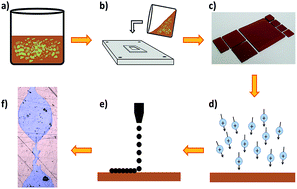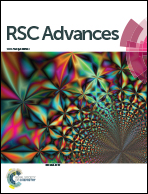Inkjet-printed PEDOT:PSS electrodes on plasma-modified PDMS nanocomposites: quantifying plasma treatment hardness†
Abstract
Nanostructured polymeric composites are promising materials for the fabrication of piezoresistive devices because they show a huge variation in electrical resistance when subjected to mechanical deformation. Quantum tunneling composites feature a conduction mechanism occurring between the metallic filler and copper particles embedded in a polydimethylsiloxane (PDMS) insulating matrix, and the mechanism is enhanced by the spiky morphology of the particles. PEDOT:PSS electrodes are patterned on either side of the composite by inkjet printing, a technology that allows one-step fabrication processes. The adhesion and spreading of conductive printed ink drops are controlled and enhanced by pre-treating the samples surface in an atmospheric pressure plasma customized system. Because of an extremely high metal to polymer ratio, which results in the different surface and dielectric properties of the composite, conventional plasma conditions are not suitable to allow the control of spreading. The optimal plasma conditions for ink/surface compatibility were found using quantitative comparison based on image analysis and numerical interpretation of the adhesion/roughness properties such as bulging and spread.


 Please wait while we load your content...
Please wait while we load your content...